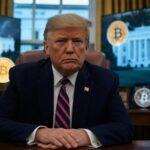Now Reading: Trump Says There Is ‘Virtually No Inflation.’ Here’s What You Need to Know
-
01
Trump Says There Is ‘Virtually No Inflation.’ Here’s What You Need to Know
Trump Says There Is ‘Virtually No Inflation.’ Here’s What You Need to Know
:max_bytes(150000):strip_icc()/TrumpVsPowell2-8d93e0ab522749b1b8a8f0a77d76a7ee.jpg?w=1920&resize=1920,1267&ssl=1)
:max_bytes(150000):strip_icc():format(jpeg)/TrumpVsPowell2-8d93e0ab522749b1b8a8f0a77d76a7ee.jpg)
Key Takeaways
- In a social media post on Monday, President Donald Trump criticized the Federal Reserve for not cutting interest rates, saying there is “virtually no inflation.”
- The most recent report on consumer inflation showed that inflation has slowed, but is still above the Federal Reserve’s goal of 2% annually.
- Central bankers are content to hold their interest rate at an elevated level while they wait and see what effects tariffs have on the economy.
In his latest criticism of the Federal Reserve, President Donald Trump said there is “virtually no inflation,” but central bankers could beg to differ.
In a post on the social media platform Truth Social Monday morning, the president argued that the Federal Reserve should cut interest rates because consumer costs are trending “so nicely downward.” While price increases have slowed in recent months, inflation is still above where the Federal Reserve would like it to be to make cuts to its influential federal funds rate.
Here’s what you need to know about inflation and interest rates right now.
What’s Happening With Inflation?
In the most recent report on consumer prices, overall inflation was up 2.4% over the same time last year, still above the Federal Reserve’s annual goal of 2%.
Trump also said food prices have “substantially lowered” and energy costs were “way down.”
Energy prices fell by 3.3% in March from last year. However, not all energy was cheaper. The cost of gasoline fell significantly and outweighed electricity and natural gas increases. Food prices grew 3.0% from the same time last year.
Food and energy prices can fluctuate from month to month for reasons that have little to do with broader inflation trends. For that reason, economists and Fed officials often pay special attention to “core” inflation measures, which exclude prices for food and energy. That number rose 2.8% over the last 12 months, the smallest increase since March 2021.
Why Does It Matter to the Federal Reserve?
The Federal Reserve uses its influential federal funds rate to help curb inflation, which is defined as a broad rise in prices for goods and services over time.
When the fed funds rate is higher, borrowing, including on credit cards and through loans, is more expensive. That often decreases consumers’ and businesses’ spending, which, in turn, should help moderate the rate of price increases.
The Fed has set its annual inflation goal at 2% because of the dual mandate Congress gave the central bank: keep inflation low and employment high. To balance those two things, the Fed has to find a place where its key interest rate is high enough to keep inflation from flaring, but low enough that it doesn’t constrict hiring.
The Federal Reserve pushed its rates to a peak of 5.25%-5.50% in the wake of the pandemic, when inflation flared. As inflation started to slow, the Fed gradually cut its rates by a full percentage point late last year.
However, despite Trump’s persistent comments that they should, central bankers have not touched the rate so far this year.
What Happens Next?
Part of the reason the Fed is content to hold its influential interest rate is that what happens next with inflation is murky.
Since the beginning of the year, Trump has implemented several tariff policies that economists expect will push up prices on items across the economy. The policies’ off-again, on-again nature has created uncertainty in financial markets and depressed consumer and business leader sentiment about the economy’s future.
The uncertainty has left central bankers in “wait-and-see” mode as they look for the effects of tariffs on the economy. After their last meeting in March, Fed Chair Jerome Powell said they were in no hurry to cut rates.
“The new administration is in the process of implementing policy changes in four distinct areas: trade, immigration, fiscal policy, and regulation. It is the net effect of these changes that will matter for the economy, and for the path of monetary policy,” he said. “While there have been recent developments in some of these areas, especially trade policy, uncertainty around the changes and their effects on the economic outlook is high.”
If Trump’s highest tariff proposals are enacted, inflation could jump to 4.7% by the end of the year, by one estimate. If that happens, it would likely encourage the Fed to raise rates further, rather than cut them.













:max_bytes(150000):strip_icc()/GettyImages-2189904112-67f083adb9cb4165b89b5bbc902b302b.jpg?w=1024&resize=1024,1024&ssl=1)
:max_bytes(150000):strip_icc()/GettyImages-2220646012-ff17aa5d0c774933806f095204c77771.jpg?w=1024&resize=1024,1024&ssl=1)
:max_bytes(150000):strip_icc()/GettyImages-2218163409-6677086129dd4188be2cf83b0f087c7b.jpg?w=1024&resize=1024,1024&ssl=1)











:max_bytes(150000):strip_icc()/GettyImages-2189904112-67f083adb9cb4165b89b5bbc902b302b.jpg?w=150&resize=150,150&ssl=1)


